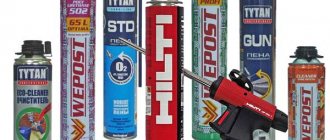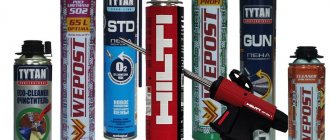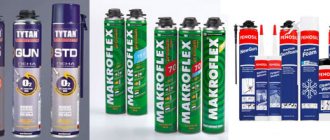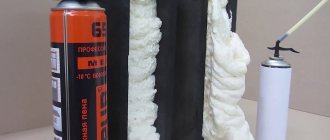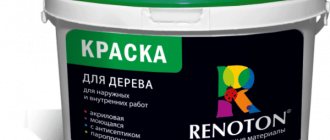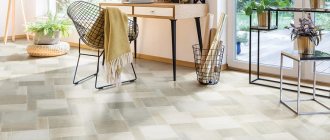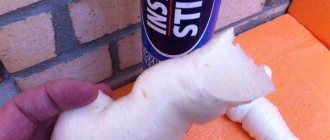Polyurethane foam appeared relatively recently. Moreover, as usually happens with interesting discoveries, it was invented by accident. The German inventor Otto Bayer succeeded in this. The latter experimented in the laboratory with polyurethane. In the 70s of the last century, scientists managed to place this mixture in an aerosol can. This caused widespread demand for it in society. In Russia, the first sales of polyurethane foam began in Moscow during the Soviet era. However, it soon began to appear in other cities of the country. Today, polyurethane foam is used for insulation, sound insulation, installation of door and window openings, as well as filling voids. Its operating principle is quite simple. Initially it is in a liquid state, but after spraying and due to contact with water and air, polyurethane is formed. Some people also use foam as decoration. Sculptures, figurines and much more are created from it.
According to their characteristics, foams differ in composition, temperature of use, type of packaging, flammability class, scope of application and price. To understand all these details, we turned to the blogger of the construction YouTube channel and master finisher Pavel Sidorik .
Key Features
Reliability of polyurethane foam parameters can be achieved by following the technological process when installing a plastic window and by choosing the right material. The characteristics of the foam must correspond to the conditions in which it is intended to be used: humidity, temperature, time of year and subsequent finishing of window slopes .
Installation of plastic windows is not complete without the use of polyurethane foam.
This modern material recently appeared on the construction market and gained its popularity along with metal-plastic structures, since the technology for their installation cannot be done without polyurethane foam. The mixture has high adhesive properties, does not allow electric current to pass through, easily fills hard-to-reach voids, is not subject to rotting and has heat and sound insulation qualities.
Composition and scope of application
On the modern market there are many already proven brands and unknown brands of polyurethane foam, but in essence, it is a one-component polyurethane foam sealant in aerosol packaging. The liquid prepolymer is displaced from the cylinder using gas - a propellant, which is under conditions of excess pressure.
After spraying the composition, its polymerization occurs - hardening under the influence of moisture from the air. As a result, a porous material similar to foam plastic is formed, which can be used for slopes and processed in any necessary way: cut, puttyed or plastered.
Putty and other finishing materials can be applied to the hardened foam.
This material is used for installation and repair of window frames, door frames, window sill boards, and other structures made of concrete, plastic, metal and wood. Polyurethane foam is used when installing windows and doors to seal seams and cracks.
When working with polyurethane foam, you do not need to have any special skills. It does not require the use of additional devices or sources of electricity.
Rating of the best polyurethane foams
| Nomination | place | Name of product | price |
| TOP of the best polyurethane foams | 1 | Penosil GoldGun 65 | 616 ₽ |
| 2 | Soudal | 365 ₽ | |
| 3 | Makroflex Standard | 350 ₽ | |
| 4 | Titan O2 | 430 ₽ | |
| 5 | Ultima | 176 ₽ | |
| 6 | TechnoNIKOL 65 Constant | 421 ₽ | |
| 7 | Moment Installation | 194 ₽ |
Penosil GoldGun 65
Penosil GoldGun 65 polyurethane foam is chosen mainly by professional builders. They note the ideal combination of price and quality of the Estonian product. Experts also note that there is no shrinkage and little re-expansion, which makes the composition predictable. The foam earned special praise from experts for its highest yield. The material has a wide range of applications, from installing window and door frames to filling all kinds of voids.
According to experts, Penosil GoldGun 65 polyurethane foam deserves the highest rating for its high quality, reasonable price, consistently white color and record volume output. One can only criticize the foam for its fear of low temperatures.
Properties
This material is characterized by:
- the volume of foam, which indicates the size of the cylinder;
- adhesion, that is, the force of adhesion to the surface;
- foaming, which means the transformation of the composition from a liquid state to foam;
- expansion, which tells how much the volume of the foam increases during the hardening process. This indicator is important if sealing of deep seams and joints is required;
- secondary expansion.
The coefficient of expansion of foam is especially taken into account when working with deep gaps.
The indicator of secondary expansion has a negative effect and can play a cruel joke if this property of polyurethane foam is ignored. For example, when installing metal-plastic structures in the form of windows and doors, as a result of the secondary expansion of the foam, additional pressure occurs on the structural elements with their subsequent deformation. To prevent this, spacers must be installed during window installation.
Spacers prevent window deformation
Foam cannot be used for installation purposes on icy, polyethylene, Teflon, silicone and oily surfaces.
Positive qualities of polyurethane foam:
- non-passage of electric current;
- multifunctionality of use - as insulation, sealant, adhesive and soundproofing composition;
- water-repellent properties;
- fire safety class B1;
- due to its ability to significantly increase in volume, the foam effectively fills the most inaccessible places: seams, cracks, recesses, quickly hardening;
- the applied composition does not rot and is not afraid of mold;
- has high thermal insulation qualities;
- can be used for fixing water supply and heating pipes, electrical wiring;
- used as a sealant with insulating properties when installing roofing materials;
- polyurethane foam when installing windows, due to its high adhesive properties, ensures reliable fixation of window and door blocks without the use of nails and screws;
- Soundproofing qualities allow you to dampen noise from vibrations. When installing plastic windows, this property complements the quality of the design and enhances the effect of soundproof rubber seals installed in the window.
Polyurethane foam reliably fixes window or door structures
. Disadvantages:
- despite the fact that the material repels water from its surface, moisture can accumulate in its porous structure, which over time destroys the structure of the foam and reduces its performance properties;
- destroyed by direct solar radiation;
- the presence of strict requirements for the storage of cylinders - vertical position and ambient temperature from not lower than 5 and not higher than 25 degrees;
- After contact with human skin, it is very difficult to wipe off and only with the help of solvents, so it is important to use gloves when working with foam.
Foam got into the wrong place - what to do?
Finally, there is one more question that deserves our attention - how to wash polyurethane foam from plastic windows, hands, clothes and other objects. No matter how hard we try, and no matter how carefully we work, polyurethane will appear almost everywhere.
The foam can be completely removed from the hands only together with the skin, alas. So don’t neglect gloves!
When troubleshooting problems, I advise you to use the information from the table below:
| Where did it go? | Fresh foam | Dried foam |
| Hands | Carefully remove with a sponge or rag, remove the residue with any solvent, and then apply a protective cream. | Carefully cut as close to the skin as possible, and scrape off the remains with sandpaper (by hand, of course, without a sanding machine!). It is completely removed only from the top layer of skin, so you have to wait two to three days. |
| Cloth | We collect the foam with a spatula, a piece of cardboard or any other object, and wipe off the residue with a solvent. The stains will still remain. | We cut off the foam, clean off large residues, polyurethane stuck between the threads, and dissolve it with various compounds. The likelihood of complete stain removal is even lower than with fresh foam. |
| PVC profile | In both cases, we carefully remove large fragments, and wipe off the remains either with special napkins or with a foam solvent. If the polyurethane has dried out, you need to take the composition marked “for already installed windows.” | |
| Flooring | Remove with a spatula or a handy object, wipe the area with a sponge soaked in solvent. A wooden surface can be sanded, but it is difficult to save a varnished surface even when using a special composition. | We cut off the foam and sand the remains with fine sandpaper. Then we treat it with either a composition for removing polymer sealant or a Dimexide solution. Stains remain in almost 100% of cases. |
In general, special formulations (wipes or sprays) designed specifically for working with polyurethane help best. But they are expensive, so it’s unlikely that anyone will buy such material without professionally installing windows.
Probably the most effective foam removal wipes
Moral: in order not to look for how to wipe foam from a plastic window or other surfaces, you need to be extremely careful. Therefore, until the installation of the structure is completed, you should not remove the protective film from the windows, and the floor and other surfaces should be covered with polyethylene. Well, the clothes should be work clothes: a) you don’t mind them and b) they protect the skin from contact with adhesive material.
Before chemical removal, we clean off everything that is being cleaned.
Varieties
If the composition of the material from different manufacturers has slight differences, then depending on the design of the cylinder itself, the foam can be professional or household.
Professional
Professional or pistol foam is characterized by its use in conjunction with an applicator gun as a device for dosing the material . For this purpose, the cylinder design is equipped with a special working valve onto which the gun is placed.
In professional construction, foam is used with an applicator gun
The use of a dosing device allows you to deliver material portionwise into cracks and recesses, control the amount of material and save its consumption. The device itself is ergonomically designed and allows you to operate with one hand using the trigger and handle. A long thin metal nozzle allows you to feed material into the recesses. In this case, the position of the bottom of the cylinder does not matter.
The applicator gun is a professional device and therefore has a high cost. It is purchased by builders and installers whose field of activity is directly related to its use.
The applicator gun allows you to use the cylinder in any position
Modern cylinders are equipped with reusable valves. This ensures that the container is tightly closed and the contents are preserved until the next use without losing its quality or drying out. The mechanism for attaching the cylinder to the gun can also be different: the valve can be threaded and screwed onto the gun or fastened.
Household
For household use, it makes no sense to purchase a dispenser gun, since caring for it requires special aerosol solvents, which also cost money.
For one-time use, it is more advisable to use a container with a plastic tube
For occasional home use, manufacturers offer household polyurethane foam. It is also called semi-professional or manual and is represented by only one cylinder without additional devices, except for a nozzle in the form of a plastic tube, which is put on the valve before starting work.
Classification by seasonality
Depending on the temperature requirements, polyurethane foam can be:
- summer;
- winter;
- all-season.
Summer foam is recommended to be used at temperatures from 5 to 35 degrees. Winter foam is used at temperatures from 18 degrees below zero to 35 degrees plus. The presence of special additives and additives ensures the polymerization process under conditions of low atmospheric humidity. It is important to remember that the higher the air temperature, the greater the expansion coefficient of the foam and vice versa.
The expansion coefficient of foam depends on the air temperature
The all-season option is rarely seen on the shelves of construction stores, since this material is relatively new and is not produced by all manufacturers. The composition is characterized by improved qualities compared to the winter and summer versions, has an increased expansion coefficient and a high foaming rate at temperatures down to minus ten degrees.
Winter or summer?
Foam is divided according to the seasonality of its use. It happens:
- Summer, suitable for work at temperatures above +5 ˚С.
- Winter, allowing you to seal cracks at temperatures down to -18˚ C.
- All-season. Seen and used less frequently. Professionals advise using it during transition periods in autumn and winter or getting by with the first two varieties.
Selection rules
The modern construction market offers a huge selection of these products from both well-known manufacturers and new companies. To make the right choice, it is important to pay attention to the following points.
Taking the cylinder in your hands, check it for underfilling, comparing the actual weight with the declared volume. A 750 milliliter cylinder should weigh from 850 to 920 grams. If there is not enough foam in the cylinder, the internal pressure will drop low enough and some of the foam will remain inside.
When purchasing a foam canister, you need to pay attention to the expiration date.
The percentage of secondary expansion, which occurs after a certain period of time - up to several days, is very important. It should not exceed the primary value by more than 20 percent, otherwise deformation of structures will occur due to additional load. .
The foam should adhere well to the surface, not flow off it, and have low shrinkage and elasticity. You need to purchase a bottle with a fresh expiration date.
Rules of application
By following simple rules during work, you can ensure that the polyurethane foam when installing plastic windows will last a long time and retain its quality.
Considering that polymerization occurs in a humid environment, the surface should be moistened with water before work. As a result, hardening will occur quickly and the expansion coefficient of the foam will increase.
When working in winter, it is necessary to clear the surface of ice and frost.
Before application, shake the container vigorously for 60 seconds. In winter, the cylinder should be at room temperature.
When spraying the contents, the container should be held with the bottom up to concentrate the composite in the valve area. This will prevent a drop in internal pressure and allow the entire foam to be used.
When spraying the composition, the container must be held upside down.
When filling a seam, you need to start work from the bottom and move up with a uniform movement of the cylinder. In this case, the seam must be filled 50%. If it is very deep, then this can be done in several passes, and each previous layer should set well.
It will take approximately 8 hours for the foam to completely harden, this indicator is related to the ambient humidity and temperature.
After hardening, excess foam is cut off with a knife.
When the foam has hardened, you can cut off its excess with a knife and carry out work to protect its surface from external influences, such as moisture and sun. The foam can be plastered, puttied or painted. When installing plastic windows, it is hidden under casing or flashings.
How to clean at home
It is easy to remove foam at home. There are special aerosols that remove stains from skin and clothing. Also use a few more tools:
- Vegetable oil. It is harmless and gently removes foam from surfaces. You can speed up the process by just heating the oil a little.
- Solvents from Tytan, Bau Master, Soudal. They do not cause mechanical damage and effectively remove foam and its traces.
- Acetone. Wipe skin quickly and wash with plenty of soap and water. Sometimes a remover (nail polish remover) is used instead of acetone.
- Salt baths. Polyurethane foam is much easier to remove from steamed skin.
Common brands
The most common and well-established brands of polyurethane foam in the construction market are the following:
- Moment-Montazh;
- Makroflex;
- Soudal.
“Moment installation” is the most common option, produced for domestic and professional use. According to seasonality - usually all-season. It has high adhesive properties. Due to its dense and homogeneous structure, it is most often used when installing metal-plastic structures.
"Makroflex" is also often found in stores. Suitable for use on any surface. Has a low coefficient of secondary expansion. Divided according to seasonal use.
"Soudal" is not often found on sale, but this foam is worth looking for as it has excellent qualities. It is characterized by the absence of toxins and specific odor, good density and low porosity. In addition to winter and summer foam, the manufacturer produces fire-resistant options.
Vote
What would you choose or recommend?
Kraftool Krartflex Premium
0.00 % ( 0 )
Makroflex Standard
0.00 % ( 0 )
MAXFORTE FOAM SOUNDFLEX
18.18 % ( 2 )
Tytan Professional STD
36.36 % ( 4 )
Penosil GoldGun65
0.00 % ( 0 )
Profflex PRO Gold
0.00 % ( 0 )
Irfix STD
0.00 % ( 0 )
Moment Installation
0.00 % ( 0 )
Tytan O2
27.27 % ( 3 )
Soudal Soudafoam
18.18 % ( 2 )
